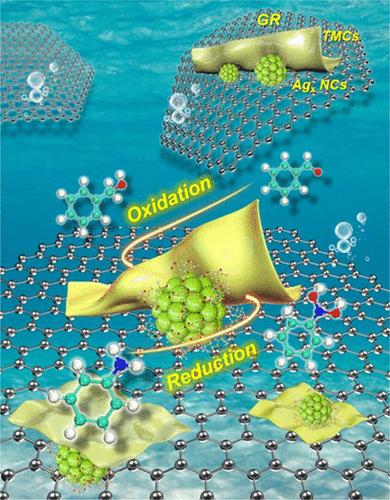空间限制原子精确金属纳米团簇引导光氧化还原有机转化
IF 4.7
2区 化学
Q1 CHEMISTRY, INORGANIC & NUCLEAR
引用次数: 0
摘要
原子精密金属纳米团簇(NCs)作为一类新型光敏剂出现,其特点是其离散能带结构和丰富的催化活性位点;然而,它们在多相光催化中的广泛应用仍然受到超短载流子寿命、有限的稳定性和电荷传输调节复杂性的挑战。在这项工作中,我们概念性地通过级联静电自组装策略设计了光敏和石墨烯(GR)封装的过渡金属硫族化物(TMC) (GR/金属NCs/TMC)异质结构。在这种多层三元异质结构中,金属nc集成在tmc和GR纳米片之间,作为光敏剂增强了tmc的光吸收,同时增加了复合光系统的载流子密度。金属纳米碳管和金属纳米碳管之间良好的界面电荷输运以及GR优越的吸电子能力同时促进了金属纳米碳管之间的电荷分离。得益于这种特殊的载流子传输特性,自组装的GR/金属NCs/ tmc异质结构在选择性光氧化还原有机转化方面表现出显著增强和稳定的光活性,包括在可见光下芳香硝基化合物的光催化厌氧还原为氨基衍生物和芳香醇的光催化氧化为醛。此外,光催化过程的机制也得到了明确的阐明。我们的工作为在工程光系统中定制原子精确的金属nc提供了一个典型的范例,旨在将太阳能转化为化学能。本文章由计算机程序翻译,如有差异,请以英文原文为准。

Spatially Confining Atomically Precise Metal Nanoclusters Steers Photoredox Organic Transformation
Atomically precise metal nanoclusters (NCs) emerge as a novel class of photosensitizers, distinguished by their discrete energy band structures and abundance of catalytically active sites; however, their broader adoption in heterogeneous photocatalysis remains hindered by the challenges of ultrashort carrier lifetimes, limited stability, and the complexity of charge transport regulation. In this work, we conceptually design the metal NCs photosensitized and graphene (GR)-encapsulated transition metal chalcogenide (TMC) (GR/metal NCs/TMCs) heterostructure via a cascade electrostatic self-assembly strategy. In this multilayer ternary heterostructure, metal NCs are integrated between TMCs and GR nanosheets, which act as photosensitizers for enhancing the light absorption of TMCs and meanwhile increase the carrier density of composite photosystem. The favorable interfacial charge transport between metal NCs and TMCs along with the advantageous electron-withdrawing capability of GR simultaneously boosts charge separation over metal NCs. Benefiting from such peculiar carrier transport characteristics, the self-assembled GR/metal NCs/TMCs heterostructure demonstrates remarkably boosted and stable photoactivities toward selective photoredox organic transformation, including photocatalytic anaerobic reduction of aromatic nitro compounds to amino derivatives and photocatalytic oxidation of aromatic alcohols to aldehydes under visible light. Furthermore, the mechanisms underlying the photocatalytic processes are elucidated with clarity. Our work affords a quintessential paradigm for customizing atomically precise metal NCs in engineered photosystems aimed at converting solar energy into chemical energy.
求助全文
通过发布文献求助,成功后即可免费获取论文全文。
去求助
来源期刊

Inorganic Chemistry
化学-无机化学与核化学
CiteScore
7.60
自引率
13.00%
发文量
1960
审稿时长
1.9 months
期刊介绍:
Inorganic Chemistry publishes fundamental studies in all phases of inorganic chemistry. Coverage includes experimental and theoretical reports on quantitative studies of structure and thermodynamics, kinetics, mechanisms of inorganic reactions, bioinorganic chemistry, and relevant aspects of organometallic chemistry, solid-state phenomena, and chemical bonding theory. Emphasis is placed on the synthesis, structure, thermodynamics, reactivity, spectroscopy, and bonding properties of significant new and known compounds.
 求助内容:
求助内容: 应助结果提醒方式:
应助结果提醒方式:


